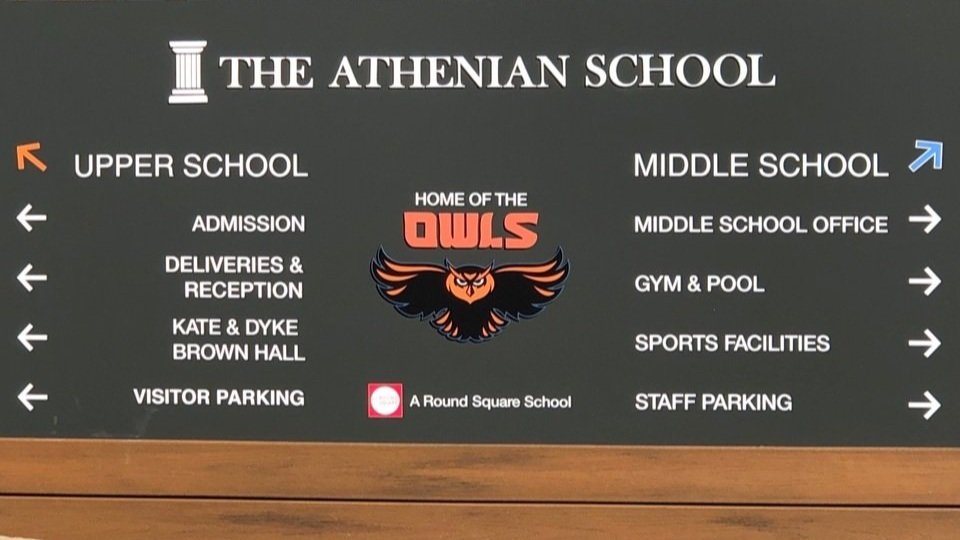Beyond The MPR: The Disconnect Between the Middle and Upper Schools
To many Athenians, the Middle School is simply the area past the gym where the loud kids on the bus go. Maybe they’ll see a few kids around the Main Hall who are too short to be freshmen, or have an eighth grade prodigy or two in their Algebra II or Spanish class. But to others, it’s full of nostalgic memories.
The Middle School and the Upper School are related on an administrative level, as they are two parts of one institution, but in the daily life of an Athenian, they’re notably disconnected, in terms of the campuses as well as students’ personalities.
“Middle schoolers tend to worry more about little things than high schoolers do,” Peter Bonfanti, Middle and Upper School math instructor, said. “For example, they might be really worried about whether they can put their graph above or below a certain line when it really doesn’t matter.”
Some of these more trivial differences may owe simply to the different ages of the students.
“High schoolers are much better at articulating when something isn’t the way they think it should be, like if your grading isn’t fair or they need more time for an assignment,” Bonfanti said.
However, Middle and Upper School students also have different experiences of Athenian education. Middle schoolers are involved in more experiential learning activities than high schoolers, partially because of the nature of the two educational levels.
According to Lauren Railey, Middle School Head, Assistant Head, and Acting Head of School, the Upper School may indeed start to see more experiential education. “Part of our strategic plan…[is that] we’re looking at the curriculum six through 12 to find ways that it can be more cohesive, include more CIS instruction, and also be more project-based and experiential in the Upper School” Railey said. “We’d like to have it be more unified, and…we are moving in that direction.”
The Middle and Upper School administrations are not nearly so distinct as in student and faculty ranks and are in almost constant communication.
“We have a leadership team,” Railey said. “That’s where we all meet and try to make big decisions…about policies and think about kids six-through-12.” This leadership team is called the Leadership Committee, formerly known as the Head’s Advisory Committee, and is concerned with the logistics of running a school. There is a separate committee that has more of an effect on Athenian life.
“We also have a Teaching and Learning Committee,” Railey continued. “That’s a six-through-12 committee that Meadow and I chair together…and [on it are] deans who are in charge of different aspects of teaching and learning. We talk a lot about the best ways to teach and how kids learn most effectively, and what that looks like in a middle school and in an upper school.”
The Upper School is intended, to an extent, to build on a Middle School education, although the existence of Upper School students who did not attend the Middle School limits this cohesion.
“We certainly try with skills like writing and math to have a sequence of skills [that] build on each other,” Railey said. “The connections are about general skills students will develop in terms of their academic performance.”
Some eighth graders, and occasionally seventh graders, also take language and/or math classes in the Upper School so that they can continue learning the subject at an advanced level. “The most noticeable thing about taking upper school classes is how disconnected it feels going between the middle school and upper school,” Cameron S. ’23, who took Chinese II and Algebra II Honors in eighth grade, said.
While the overarching vision for the two schools is connected, it is unlikely, according to Railey, that the students start to interact significantly more.“There are always ways for the students to interact in really positive ways,” Railey said. “But I’m not sure most high school students really want to interact a lot with middle school students.
The disconnect between middle schoolers and high schoolers is not insignificant, but varies depending on the student. “[I think] Upper schoolers who came from the Middle School seem to be more down on the middle schoolers because it reminds them of when they were kids,” Bonfanti said. “Upper schoolers who didn’t come up from the Middle School have much less of an opinion about the Middle School.”
Some Upper School students do, in fact, support more connections between the two. “Upper School students should be more involved in Middle School classes, presentations, and Focus Days, and Middle School students should have a larger degree of access to Upper School resources and teachers,” Jacob T. ’22, who took Spanish II in 8th grade, said in an email.
The existing interactions between middle and upper schoolers often end up being, if not positive, neutral and respectful. “As I’ve noticed with the Athenian community, outsiders are so well…integrated with the other students,” said Roark G. ’26, an eighth grader enrolled in French III Honors and Algebra II Honors. “I’ve been well accepted by my peers and teachers. Many think I am, in fact, a high school student.”
There is also the potential for larger-scale interactions, like all-school meetings, that could build a sense of community between the schools.
“It’s sad we’ve missed Convocation for two years now,” Jacob T. said. “As an event that involves both schools, it puts the entire Athenian School and its students into perspective.”
While the Middle and Upper Schools will likely remain mostly separate, there may be even more avenues for connection, and those that exist can be truly valuable to students.
“I am so excited to join the high school community next year…[especially] because I have an idea of what my future will look like,” Roark G. said.

